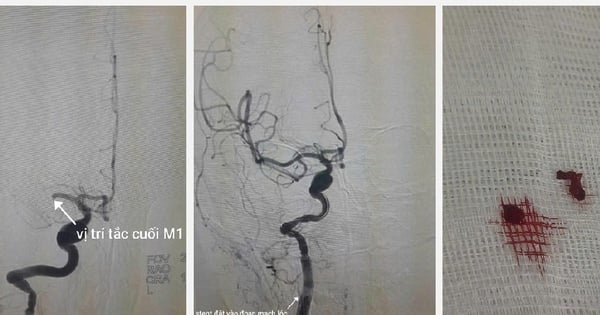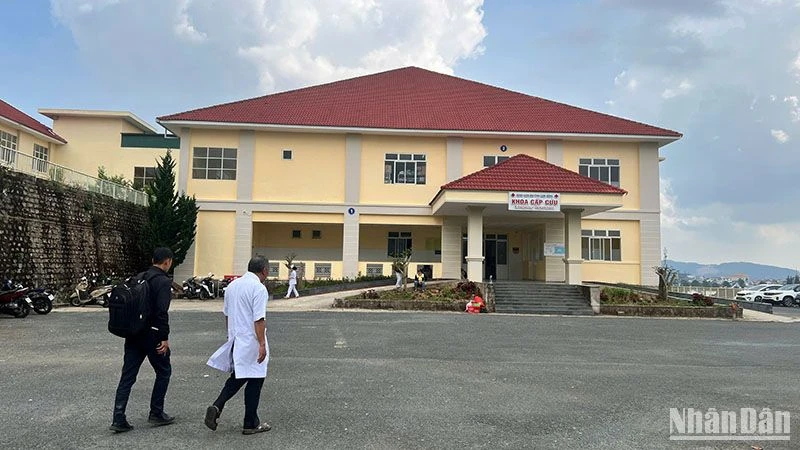Hanoi Ms. Minh, 64 years old, had a headache and numbness in her limbs for three days, thought to be a stroke, but the doctor discovered extraspinal hematoma - a disease with a rate of 1/1,000,000 people.
Previously, Ms. Minh was diagnosed with left occipital neuralgia, and took medication but the numbness in her limbs did not decrease. Recently, her condition worsened, so she went to Tam Anh General Hospital in Hanoi for examination. The MRI scan results showed a large hematoma in the neck, 6 cm long, from the C3-C7 vertebrae, causing cervical spinal cord edema.
On March 29, Dr. Nguyen Duc Anh, Head of the Department of Neurosurgery, said that Ms. Minh had spontaneous epidural hematoma, which is a blood clot in the space between the dura mater and the bone, of unknown cause.
"This is a rare disease, with a rate of 1/1,000,000 people, estimated to account for about 0.3-0.9% of epidural injuries," said Dr. Duc Anh, adding that Vietnam currently has few reports of cases related to epidural hematoma that have been treated surgically. At Tam Anh General Hospital in Hanoi, Ms. Minh is the second case since the hospital was established.
Mrs. Minh's illness is in a dangerous stage, the blood clot can compress the spinal cord causing difficulty breathing, respiratory failure, risk of cervical spinal cord injury, quadriplegia, hemiplegia.
The patient was indicated for endoscopic surgery to remove the hematoma and reduce compression on the spinal cord. Through a small incision of about 3 cm, the doctor inserted specialized equipment to access the spinal area containing the hematoma. The endoscopic screen magnified the damaged area, helping the team clearly observe and remove the entire hematoma, freeing the compressed spinal cord and nerves.

Dr. Duc Anh (right) performs endoscopic surgery to remove a blood clot for Ms. Minh. Photo: Tam Anh Hospital
Doctor Duc Anh added that endoscopic surgery to treat epidural hematoma is minimally invasive, preserving maximum spinal structure, helping patients recover quickly, with less pain, less bleeding, and minimizing damage during surgery.
Two days after surgery, Ms. Minh's numbness in her limbs and neck pain were gone, she could move lightly and was discharged after 5 days.
If not detected and controlled well, extraspinal hematoma has the risk of progressing, compressing the spinal cord and nerves, causing irreversible damage. Factors that increase the risk of the disease include blood clotting disorders, tumors, vascular malformations, infections or trauma, patients with high blood pressure, and those taking anticoagulants. Symptoms are easily confused with other diseases such as stroke.
Dr. Duc Anh recommends that people with neck and back pain, decreased mobility, numbness in limbs, etc. should see a doctor early to prevent nerve damage. Patients should choose a medical facility with high expertise in the field of neurology and spine for accurate diagnosis. People with a history of underlying neurology and spine diseases, high blood pressure, and use of anticoagulants should follow the doctor's treatment regimen and have regular health check-ups.
Linh Dang
* Patient's name has been changed
| Readers ask questions about neurological diseases here for doctors to answer |
Source link


![[Photo] Looking back at the impressive moments of the Vietnamese rescue team in Myanmar](https://vstatic.vietnam.vn/vietnam/resource/IMAGE/2025/4/11/5623ca902a934e19b604c718265249d0)


![[Photo] "Beauties" participate in the parade rehearsal at Bien Hoa airport](https://vstatic.vietnam.vn/vietnam/resource/IMAGE/2025/4/11/155502af3384431e918de0e2e585d13a)



























![[Photo] Summary of parade practice in preparation for the April 30th celebration](https://vstatic.vietnam.vn/vietnam/resource/IMAGE/2025/4/11/78cfee0f2cc045b387ff1a4362b5950f)




























































Comment (0)